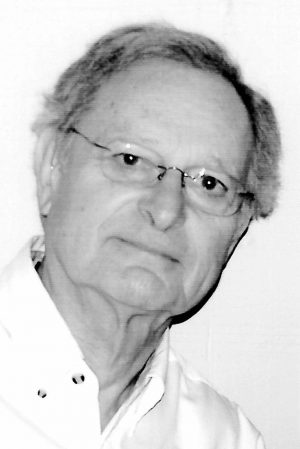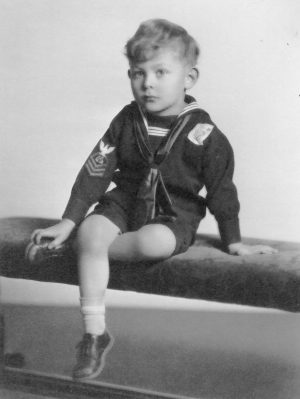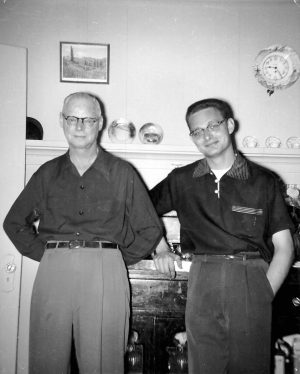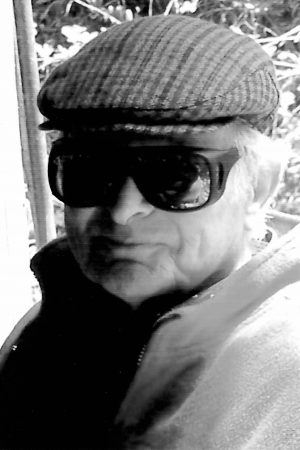Tom Hart: Saxophone
by Alex Walsh
 “Albert G. Hart, was born in Ohio in 1848. In the early ‘60’s he crossed the plains with his two brothers and saw active duty in the Indian wars in Montana. Coming to California in 1874, he engaged in mining and farming. He was in San Francisco at the time of the building of the first cable-car railroad and operated the first car that ran over the line.” – Oakland Tribune
“Albert G. Hart, was born in Ohio in 1848. In the early ‘60’s he crossed the plains with his two brothers and saw active duty in the Indian wars in Montana. Coming to California in 1874, he engaged in mining and farming. He was in San Francisco at the time of the building of the first cable-car railroad and operated the first car that ran over the line.” – Oakland Tribune
Tom Hart, the grandson of Albert G. Hart, is a native San Franciscan, born in 1926, who still lives in the same house his father bought in 1942.
“My father bought the house for $5000, with a down payment he saved up as a pharmacist. This was during the war, when they had black-outs in the City. The person who sold it was afraid of the Japanese submarines off the coast.”
Tom’s father was an ambulance driver in WWI. After the war, he took a UC Extension course, got a certificate, and started his own pharmacy. He lost his business (three stores), in the great depression, and ended up working as an assistant manager for Walgreen’s until he retired.
Tom was an only child, whose earliest memories include listening to Souza marches on his Victrola. Later, while attending Everett Jr. High, he tried out for the school band. “In those days,” he recalls, ”Harry James (trumpet) was the hero, and all the kids wanted to play like him. I tried out for trumpet, but didn’t make it. The teacher, Mr. Wemmar, needed an alto sax player for the dance band the next year. So he shoved an alto sax into my hand, gave me a copy of The Merry Widow Waltz, and sent me upstairs to the music room to work it out. When I came back down, he was very pleased. He brought in the principle and showed me off to him.”
In high school, Tom switched to tenor sax, became student leader of the dance band, and started writing his first charts. In 1944, during his junior year, he joined the Musicians Union and began playing professional gigs with bands that were hiring high school kids because of the war. “I worked several gigs with Howard Fredric’s dance band, and played with Dick Salzman’s Quartet. The group was called Dick Salzman, the Boys, and Lorellen. His wife was the singer.“
Tom graduated from Polytechnic High School in January 1945, and was immediately inducted into the Navy. After attending the Navy School of Music at Anacostia in Washington, D.C. for a few weeks, he was shipped to Calcutta, India, on a troop transport—a converted oil tanker—to play on one of the ship’s hatch covers to entertain men in the Army returning home to be discharged. The remainder of his eighteen months of service was spent in Bremerton, Washington. In the morning he played marches with the military band for the troops standing in line to be discharged, and in the afternoon, he played in the jazz band at the local Red Cross. “I was eventually made Musician Second Class, the highest rank obtainable for this short time of service. The Navy, as with the other services, thought music was important for morale.”
In August of 1946, Tom returned to San Francisco and began school at SF State under the G.I. Bill. He married his high school sweetheart, Gloria, in 1948, and they started a family. During this time, he played local gigs, including a summer at a strip club in San Francisco’s International Settlement, with his trio, which included John Markham on drums and Vince Guaraldi on piano. With school, family, and music, his life was full. “Vince Guaraldi and Eddie Duran used to come over to my house, and we would jam and make charts. We even made a demo record for Fantasy Records, but it didn’t go anywhere. I still have the record.”
Tom with his father in the 1950’s.
After getting his BA degree, Tom continued on to get his masters and teaching credential. In 1951, he was hired to teach instrumental music and chorus at Tamalpais High School in Marin County. “Teaching school was a limiting thing, as far as being a musician. I didn’t have time during the day to do justice to both, so I had to make do. But if it hadn’t been for the music business, I couldn’t have survived just teaching school. Teachers salaries were not very good.”
In 1954, Tom moved to the East Bay to teach instrumental and choral music at San Leandro High. In 1957, he moved to Arroyo High School in San Lorenzo to teach choral music, a job that lasted fifteen years, and where his daughter, Pam, and son, Kevin, were members of his a cappella choir, which won a fair share of superior ratings. During this time, he was elected president of the California Music Educators’ Association, and he adjudicated for Bay Area schools. “Every county would have a festival, and they would hire adjudicators to give them ratings. It was a cooperative idea, not a competition—a way for students to listen to, and learn from, other groups and directors.”
Tom with his son Kevin.
Tom also began working for bandleader Ray Hackett, sometimes playing two or three shows a week, a relationship that lasted thirty years. “There wasn’t much of a conflict when I was with Ray, because he would always have the rehearsals after school hours.Those were the days when a lot of the gigs consisted of corporate parties, and corporate meetings in the major hotels. They would hire major celebrities who would put on a show, which was then followed by a dance. I worked the Fairmont, the St. Francis, the Palace Hotel, and many other venues.”
Over the years, Tom’s chart writing skills became well known. “I wrote charts for Jamie Davis, vocalist for the Count Basie Band. The band recorded six of my charts with him. I did about 30 charts in all. At the same time, Jackie Ryan, vocalist for the Rudy Salvini Band, used a lot of my charts.”
During the late fifties and early sixties, Tom subbed with the Dave Brubeck Octet on occasion, and played once with the Stan Kenton Band at a USF dance. “That was scary because I was young and innocent,” he recalls. “It was interesting because Kenton was one of the major jazz bands of the era, and he still had enough of a name to go on tours. His main strength, also, was doing summer clinics at colleges along the tour. They were known as the Kenton Clinics. That was the beginning of the rise of college jazz.”
In 1971, Tom attended a Kenton Clinic at Sacramento State, and was asked by Kenton to join his band. Tom declined. “I had just signed a contract to teach jazz studies at De Anza College. So I lost the chance to be famous, or at least to play in the Kenton band. It was very problematic, risking a new job, teaching a subject that I had never taught before—my experience had been in choral music for years, not especially jazz. I wanted to make sure I stabilized my career of teaching jazz at the college level.”
When Tom started at De Anza College, he received a boost in salary, which was fortunate because corporate shows were beginning to taper off. In 1975, under Tom’s direction, the second-year jazz band won the Pacific Coast Collegiate Jazz Festival first-place trophy. He continued teaching at De Anza until he retired, eventually becoming an administrator during his final years.
In 1973, Ernie Heckscher, who led the house band at the Fairmont Venetian Room, hired Tom to play when Tony Bennett appeared. “There is a solo space in Tony’s book for the tenor saxophone. So I got a chance to play with him. From then on, he requested that I be hired whenever he came to town. This lasted for 8 years. I even got a mention in Herb Caen and John Wasserman.”
During the late 70s, Tom continued to teach and perform, conduct on occasion, and play in rehearsal bands. When Davies Symphony Hall first opened in San Francisco, he was asked to conduct a concert with the Ink Spots. Jamey Aebersold, a well-known jazz educator, clinician and music publisher, invited Tom to travel to Australia to do workshops. In 1985, Tom was asked to join the Bohemian Club, where he continues to play in, write for, and conduct the band. When he retired from De Anza College in 1988, Tom and Gloria, who was also a teacher, moved back into his parents’ house in San Francisco. “Both of my children became teachers,” Says Tom.” My son Kevin earned a Masters Degree in Music as a clarinet major at Hayward State, taught music for a number of years, and is now Superintendent at the Valley Home School District near Oakdale. My daughter, Pam, is a music teacher and administrator at Corvallis Elementary School in San Leandro, and has a degree in voice from Brigham Young University. We have over nine family members in education.”
In the 1990s, Tom served on the Local 6 Board of Directors, and was instrumental in helping the local move to its present location. In 2007, he released his first CD, It’s What It Is (For Family And Friends), which featured a quartet playing standards. Today, Tom continues to play in rehearsal bands, including Rudy Salvini’s band, the Piestrip Band, and the Bohemian Club Band. He spends hours each day writing charts on his computer and learning new bebop lines—and he has plans to record a CD of his originals.
“I’d like to be the oldest living jazz tenor player in town.”
